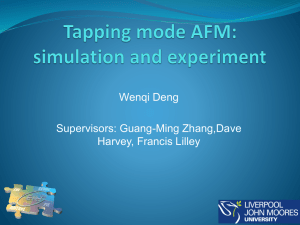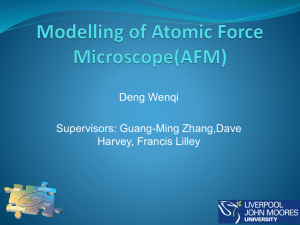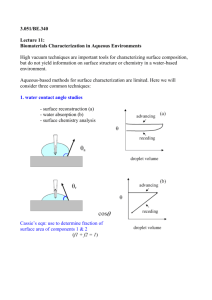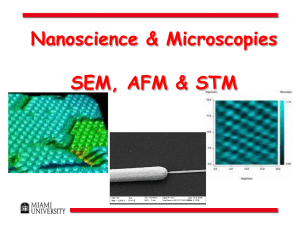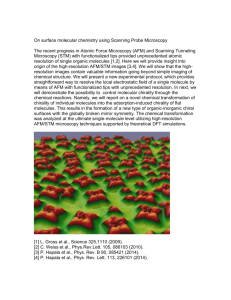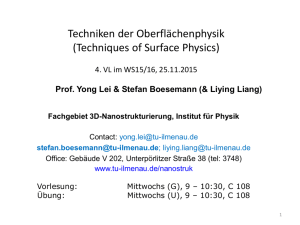1 - TU Ilmenau
advertisement
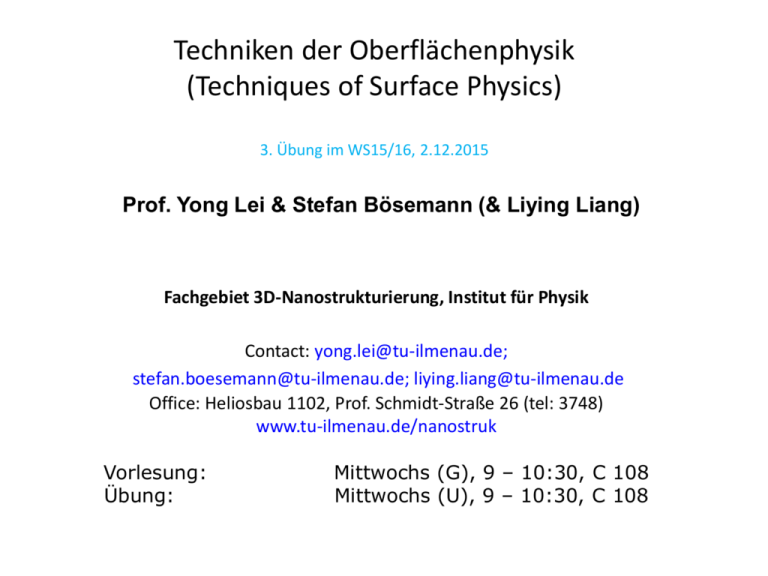
Techniken der Oberflächenphysik (Techniques of Surface Physics) 3. Übung im WS15/16, 2.12.2015 Prof. Yong Lei & Stefan Bösemann (& Liying Liang) Fachgebiet 3D-Nanostrukturierung, Institut für Physik Contact: yong.lei@tu-ilmenau.de; stefan.boesemann@tu-ilmenau.de; liying.liang@tu-ilmenau.de Office: Heliosbau 1102, Prof. Schmidt-Straße 26 (tel: 3748) www.tu-ilmenau.de/nanostruk Vorlesung: Übung: Mittwochs (G), 9 – 10:30, C 108 Mittwochs (U), 9 – 10:30, C 108 1. What is STM? How does STM work? STM: Scanning Tunneling Microscope It is an instrument for imaging surfaces at the atomic level. It can investigate and locate a single atom, showing the arrangement state of individual atoms in the material surface. The principle of STM The STM is based on the concept of quantum tunneling. Quantum tunneling refers to the quantum mechanical phenomenon where a particle tunnels through a barrier that it classically could not surmount. The phenomenon in tunneling in quantum mechanics describes an electron's penetration of an energy barrier, even though the electron's energy is below the height of the barrier. The principle of STM Probe Sample When a conducting tip is brought very near to the surface to be examined, a bias (voltage difference) applied between the two can allow electrons to tunnel through the vacuum between them. The resulting tunneling current is a function of tip position, applied voltage, and the local density of states of the sample. Information is acquired by monitoring the current as the tip's position scans across the surface, and is usually displayed in image form. 2. What is the principle of AFM? The basic principle of AFM Position Sensing Part Force Sensing Part Feedback System AFM is an analytical instrument used to study surface structure of solid including the insulator material. The surface structure and property are obtained by detecting the weak atomic interaction forces between specimen surface and micro-force sensor (cantilever). A pair of cantilever with extremely sensitive weak force is fixed at one end, and the other end of the tiny tip is brought close to the sample, then interacts with it. The force will make the cantilever be deformed or motion status change. After occurring the interaction between the tip and the sample, the cantilever will swing. When the laser irradiates at the end of the cantilever, the position of the reflected light will change with the swing, which resulted in the generation of the offset. The offset is recorded and converted into electrical signals by laser spot position detector. When scanning the sample, sensors can detect these changes, then obtaining the force distribution information, surface morphology and surface roughness information. Interaction Forces •When the tip is brought close to the sample, a number of forces may operate. The combination of these interactions results in a force-distance curve similar to that below •Typically the forces contributing most to the movement of an AFM cantilever are the coulombic and van der Waals interactions. Coulombic Interaction: This strong, short range repulsive force arises from electrostatic repulsion by the electron clouds of the tip and sample. This repulsion increases as the separation decreases. Van der Waals interactions: These are longer range attractive forces, which may be felt at separations of up to 10 nm or more. They arise due to temporary fluctuating dipoles. •As the tip is brought towards the sample, van der Waals forces cause attraction. • As the tip gets closer to the sample this attraction increases. •However at small separations the repulsive coulombic forces become dominant. The repulsive force causes the cantilever to bend as the tip is brought closer to the surface. •There are other interactions besides coulombic and van der Waals forces which can have an effect. 3. What signals are detected by STM and AFM? And how are these signals generated? The manipulation of STM The manipulation of AFM Schematic of experiment to measure the force between particles in an electric field. http://www.youtube.com/watch?v=MZb8C0f7Kdg Force as a function of applied voltage 4. How many imaging modes does AFM have? What are the differences among them? What are their advantages and disadvantages? • Three primary imaging modes: • 1. Contact AFM • < 0.5 nm probe-surface separation • 2. Tapping mode AFM (Intermittent contact ) • 0.5-2 nm probe-surface separation • 3. Non-contact AFM • 2-10 nm probe-surface separation • 1. Contact AFM •In contact mode, the tip contacts the surface through the adsorbed fluid layer on the sample surface. •The detector monitors the changing cantilever deflection and the force is calculated using Hooke’s law: F=−kx (F = force, k = spring constant, x = cantilever deflection) •The feedback circuit adjusts the probe height to try and maintain a constant force and deflection on the cantilever. This is known as the deflection setpoint. • 2. Tapping mode AFM (Intermittent contact ) •In tapping mode the cantilever oscillates at or slightly below its resonant frequency. The amplitude of oscillation typically ranges from 20 nm to 100 nm. The tip lightly “taps” on the sample surface during scanning, contacting the surface at the bottom of its swing. •Because the forces on the tip change as the tip-surface separation changes, the resonant frequency of the cantilever is dependent on this separation. •The oscillation is also damped when the tip is closer to the surface. Hence changes in the oscillation amplitude can be used to measure the distance between the tip and the surface. The feedback circuit adjusts the probe height to try and maintain a constant amplitude of oscillation i.e. the amplitude setpoint. Tapping mode in air: In this operating mode, a small piezoelectric crystal mounted in the multimode AFM tip holder makes the cantilever oscillate up and down at or slightly below its resonant frequency. The tip oscillates vertically, alternately contacts the surface and lifts off. The amplitude of this oscillation typically ranges from 20nm to 100nm. The oscillating tip lightly touches or ‘taps’ on the sample surface during scanning. When the tip comes close to the sample surface, forces like van der Waals force, dipole-dipole interactions, electrostatic forces, etc., act on the cantilever and lead to a decrease in the amplitude of oscillation. Thus, the image is obtained by imaging the force of the oscillating contacts of the cantilever tip with the sample surface. Tapping mode in fluids: Tapping mode operation in aqueous medium is a very useful tool for biologists because the samples are in a state that closely resembles in vivo environment as compared to dehydrated samples. • 3. Non-contact AFM •In non-contact mode the cantilever oscillates near the surface of the sample, but does not contact it. The oscillation is at slightly above the resonant frequency. Van der Waals and other long-range forces decrease the resonant frequency just above the surface. This decrease in resonant frequency causes the amplitude of oscillation to decrease. •In ambient conditions the adsorbed fluid layer is often significantly thicker than the region where van der Waals forces are significant. So the probe is either out of range of the van der Waals forces it attempts to measure, or becomes trapped in the fluid layer. Therefore noncontact mode AFM works best under ultra-high vacuum conditions. The Properties of the different operation modes in AFM. Advantages and Disadvantages of AFM Modes Advantage Contact Mode Tapping Mode High scan speeds “Atomic resolution” is possible Easier scanning of rough samples with extreme changes in vertical topography. Disadvantage • Lateral forces can distort the image • Capillary forces from a fluid layer can cause large forces normal to the tip sample interaction • Combination of these forces reduces spatial resolution and can cause damage to soft samples. - Higher lateral resolution (1 nm to • Slower scan speed than in contact mode 5 nm). - Lower forces and less damage to soft samples in air. - Almost no lateral forces. - Noncontact Mode - Both normal and lateral forces are minimised, so good for measurement of very soft samples Can get atomic resolution in a UHV environment • Slower scan speed than tapping and contact modes to avoid contacting the adsorbed fluid layer •Lower lateral resolution, limited by tipsample separation. •Usually only applicable in extremely hydrophobic samples with a minimal fluid layer. 5. What are the advantages and limitations of STM and AFM? The advantages and disadvantages of STM • Advantages: STM is helpful because it can give researchers a three dimensional profile of a surface, which allows researchers to examine a multitude of characteristics, including roughness, surface defects and determining things about the molecules such as size and conformation. Other advantages of the scanning tunneling microscope include: It has a high resolution in atomic level, which is considered to be 0.1 nm lateral resolution and 0.01 nm depth resolution. 3D mapping image can be easily obtained. It can observe the partial surface structure of a single atom, not average nature of the whole surface, thus directly showing surface defects. It is capable of capturing much more details than lesser microscopes. This helps researchers better understand the subject of their research on a molecular level. STM is also versatile. They can be used in ultra high vacuum, air, water and other liquids and gasses. They will operate in temperatures as low as zero Kelvin up to a few hundred degrees Celsius. • Disadvantages: The four major downsides to using STMs are: • STM can be difficult to use effectively. There is a very specific technique that requires a lot of skill and precision. • STM require very stable and clean surfaces, excellent vibration control and sharp tips. • STM only can be used to scan not easily oxidized and well conductive samples. • STM use highly specialized equipment that is fragile and expensive. The advantage and disadvantage of AFM Advantages : 1) it generates true, high-resolution 3-dimensional surface images; 2) it does not require special sample treatments that can result in the sample's destruction or alteration; 3) it does not require a vacuum environment in order to operate (it can operate in both air and liquid); 4) could be used for organic materials. Disadvantages: 1) the image size that it provides is much smaller than what electron microscopes can create; 2) it is slow in scanning an image, unlike an electron microscope which does it in almost real-time ; 3) tip convolution--not true sample topography, but the interaction of the probe with the sample surface ; 4) expensive tips. Thanks for listening Any questions? Das Lösung wird heute Abend online gestellt http://www.tu-ilmenau.de/nanostruk/teaching/ 26
